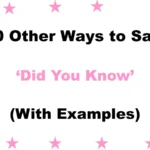Finding the right words in professional communication matters more than ever. Whether you’re sharing updates, announcements, or critical information, how you say it can impact how it’s received. While “This is to inform you” is formal and clear, it can often feel cold, robotic, or outdated.
In a world where thoughtful communication builds trust, connection, and clarity, choosing more empathetic and modern alternatives helps you stand out while maintaining professionalism. This guide offers 30 powerful, professional alternatives to help you express important information with warmth, respect, and clarity—so your messages feel not only informative but also human and considerate.
What Does “This Is to Inform You” Mean?
“This is to inform you” is a formal phrase used to introduce important information or an official notice in emails, memos, and letters. It serves as a signal to the reader that what follows is a factual statement, update, or instruction. Though clear, it can sometimes feel distant or stiff—especially when dealing with sensitive topics or human-centered messages. Using more natural phrasing can help maintain professionalism while softening the tone.
When to Use “This Is to Inform You”
- Announcing changes to policies or procedures
- Sharing official decisions or approvals
- Delivering reminders or deadlines
- Reporting status or providing an update
Is It Professional or Polite to Say “This Is to Inform You”?
Yes, “This is to inform you” is both professional and polite, but it leans heavily toward formality and can lack personal tone. It’s appropriate in legal, administrative, or governmental contexts, but in most business communication today, it may sound stiff or impersonal. Choosing a more tailored and natural alternative can help you sound more approachable while staying respectful—especially in client-facing roles or internal team messages.
Pros or Cons of Saying “This Is to Inform You”
Pros:
- Clearly signals the purpose of the message
- Universally understood in professional settings
- Appropriate for legal or highly formal documents
Cons:
- Can sound overly stiff or robotic
- May create distance in tone, especially with colleagues or clients
- Lacks emotional sensitivity in delicate matters
- Often overused and seen as outdated
Synonyms for “This Is to Inform You”
- Please be advised
- I’m writing to let you know
- Kindly note that
- I’d like to share that
- I wanted to inform you
- Here’s an update regarding
- Just a quick note to let you know
- Please be aware
- Allow me to update you
- You should be aware that
- This serves as a notification
- I’d like to bring to your attention
- Let this email serve as notice
- For your awareness
- Just keeping you in the loop
- I’m reaching out to inform you
- This message is to notify you
- You are hereby informed
- Kindly be informed
- This is to notify you
- I’d like to make you aware
- You may want to know
- This communication is to update you
- As an update
- Sharing the following for your reference
- In case you weren’t aware
- Please take note of
- Allow me to bring this to your attention
- Just to keep you posted
- As a reminder
1. Please be advised
Definition: A polite and formal way to introduce important information.
Detailed Explanation: This phrase is commonly used in official or administrative communication. It adds a layer of authority while still sounding courteous.
Scenario Example: Please be advised that our office will be closed on Monday due to a public holiday.
Best Use: In legal, HR, or compliance updates.
Worst Use: In casual team updates—may sound too stiff.
Tone: Formal and respectful.
2. I’m writing to let you know
Definition: A warm and professional way to introduce new information.
Detailed Explanation: This phrase strikes a perfect balance between clarity and tone, especially in written communication like emails.
Scenario Example: I’m writing to let you know that your application has been approved.
Best Use: Client or internal team updates.
Worst Use: In formal legal notices.
Tone: Friendly and professional.
3. Kindly note that
Definition: A gentle and respectful way to highlight something important.
Detailed Explanation: Often used in professional settings, especially when sharing deadlines, reminders, or small updates.
Scenario Example: Kindly note that the submission deadline is Friday at 5 PM.
Best Use: Admin, scheduling, and policy reminders.
Worst Use: For major announcements—can feel too soft.
Tone: Polite and informative.
4. I’d like to share that
Definition: A more personable and conversational approach to giving updates.
Detailed Explanation: This phrase adds warmth and feels less robotic, making it ideal for people-centric communication.
Scenario Example: I’d like to share that our team exceeded all KPIs this quarter.
Best Use: Team announcements, performance updates.
Worst Use: Highly formal or legal messages.
Tone: Positive and approachable.
5. I wanted to inform you
Definition: A straightforward yet professional phrase for delivering information.
Detailed Explanation: It softens the classic “inform” phrase with a past tense intro, making it feel less harsh.
Scenario Example: I wanted to inform you that your access has been approved.
Best Use: Formal updates with a human touch.
Worst Use: In overly casual chats—may sound stiff.
Tone: Respectful and clear.
6. Here’s an update regarding
Definition: A professional way to introduce a specific piece of news or progress.
Detailed Explanation: This phrase works well in ongoing communication where the recipient expects new information or a status report.
Scenario Example: Here’s an update regarding the new onboarding process for remote hires.
Best Use: Project or department status updates.
Worst Use: One-time formal notifications—it might sound too casual.
Tone: Clear and business-casual.
7. Just a quick note to let you know
Definition: A light, informal way to pass along useful information.
Detailed Explanation: Perfect for short updates where formality isn’t required but clarity still matters.
Scenario Example: Just a quick note to let you know the meeting time has been shifted to 3 PM.
Best Use: Internal communication or team announcements.
Worst Use: Legal or contractual notices.
Tone: Friendly and conversational.
8. Please be aware
Definition: A courteous and professional way to alert someone to important info.
Detailed Explanation: This phrase carries more urgency and is often used for risks, changes, or required actions.
Scenario Example: Please be aware that your password will expire in 3 days.
Best Use: Warnings, alerts, and policy changes.
Worst Use: Emotional or congratulatory messages.
Tone: Formal and cautionary.
9. Allow me to update you
Definition: A respectful and confident way to begin sharing relevant information.
Detailed Explanation: Suitable for professionals in leadership roles or client-facing communications.
Scenario Example: Allow me to update you on the next steps in the procurement process.
Best Use: Client updates, formal briefings.
Worst Use: For sensitive or highly emotional news.
Tone: Polite and structured.
10. You should be aware that
Definition: A serious and informative phrase used to bring something to attention.
Detailed Explanation: Works well when there’s an implication the recipient might not already know the information.
Scenario Example: You should be aware that the deadline has been extended by one week.
Best Use: Time-sensitive or critical business changes.
Worst Use: For casual updates—can sound too forceful.
Tone: Direct and authoritative.
11. This serves as a notification
Definition: A formal, often legal or administrative phrase signaling official communication.
Detailed Explanation: It carries weight and is commonly used in government, HR, or compliance-related communication.
Scenario Example: This serves as a notification that your employment status has been updated in our records.
Best Use: Official letters or employee notices.
Worst Use: Internal chat messages or team updates.
Tone: Highly formal and bureaucratic.
12. I’d like to bring to your attention
Definition: A polite and professional way to highlight something important.
Detailed Explanation: This phrase is effective for calling attention to details that may have been overlooked or are new.
Scenario Example: I’d like to bring to your attention the recent changes to our expense policy.
Best Use: Highlighting new information without sounding critical.
Worst Use: Very brief or fast-paced exchanges.
Tone: Thoughtful and respectful.
13. Let this email serve as notice
Definition: A formal written statement that delivers a clear and official message.
Detailed Explanation: Best suited for formal email communication that needs to be documented.
Scenario Example: Let this email serve as notice of your successful enrollment in the program.
Best Use: HR, legal, or onboarding processes.
Worst Use: Informal updates or light internal messages.
Tone: Formal and definitive.
14. For your awareness
Definition: A passive but informative phrase that gives the recipient helpful insight.
Detailed Explanation: Often used in group updates where individual action isn’t required.
Scenario Example: For your awareness, the Q3 financial report is now available on the shared drive.
Best Use: Status updates, FYIs, team broadcasts.
Worst Use: When immediate action is required.
Tone: Informative and neutral.
15. Just keeping you in the loop
Definition: A relaxed and friendly way to let someone know what’s happening.
Detailed Explanation: This phrase builds trust by showing transparency in communication.
Scenario Example: Just keeping you in the loop—we’ve confirmed the keynote speaker for the event.
Best Use: Peer-to-peer or cross-team updates.
Worst Use: Legal or hierarchical announcements.
Tone: Casual and inclusive.
16. I’m reaching out to inform you
Definition: A clear and courteous way to begin a message with purpose.
Detailed Explanation: It blends approachability with professionalism, ideal for external communication.
Scenario Example: I’m reaching out to inform you that your account will be transitioned next week.
Best Use: Client updates, external partnerships.
Worst Use: Overused in quick chats—it can feel overly formal.
Tone: Professional and sincere.
17. This message is to notify you
Definition: A formal way of stating the purpose of a communication.
Detailed Explanation: Direct and used when documentation or records are involved.
Scenario Example: This message is to notify you of a change to your billing schedule.
Best Use: Invoices, notices, and compliance documents.
Worst Use: Warm or informal team notes.
Tone: Clear and procedural.
18. You are hereby informed
Definition: An ultra-formal statement that declares official information.
Detailed Explanation: Typically reserved for government or legal usage.
Scenario Example: You are hereby informed that your request has been escalated.
Best Use: Legal notices, HR formalities.
Worst Use: Regular business communications—it can feel outdated.
Tone: Legalistic and official.
19. Kindly be informed
Definition: A courteous phrase that introduces important information softly.
Detailed Explanation: Frequently used in formal environments like academia, HR, or government.
Scenario Example: Kindly be informed that your training is rescheduled for Monday.
Best Use: Formal messages needing a warm tone.
Worst Use: Casual chats—it may feel overly formal.
Tone: Polite and respectful.
20. This is to notify you
Definition: A straightforward version of the original phrase, more modern but still formal.
Detailed Explanation: Common in company-wide emails or notices where official tone is needed.
Scenario Example: This is to notify you that system maintenance will occur on Friday.
Best Use: Official updates or internal broadcasts.
Worst Use: Informal team communications.
Tone: Formal and informative.
21. I’d like to make you aware
Definition: A respectful phrase used to inform someone of relevant or new information.
Detailed Explanation: This wording is effective when aiming to sound both thoughtful and professional, especially when highlighting something that could affect the recipient.
Scenario Example: I’d like to make you aware that the project deadline has been shifted to next Friday.
Best Use: Manager-to-employee updates or professional courtesy messages.
Worst Use: Informal team banter—it might sound too formal for casual exchanges.
Tone: Polite and businesslike.
22. You may want to know
Definition: A subtle and friendly way to offer useful information to someone.
Detailed Explanation: This phrase feels gentle and considerate, suggesting the person might find the information helpful without sounding too direct.
Scenario Example: You may want to know that the client will be visiting the office tomorrow morning.
Best Use: Cross-functional team updates or peer communication.
Worst Use: Strict policy changes or official statements.
Tone: Warm and informative.
23. This communication is to update you
Definition: A formal, structured way to open a message with a clear purpose.
Detailed Explanation: Suitable for internal memos or emails where the sender needs to convey important updates in a businesslike tone.
Scenario Example: This communication is to update you on the revised safety protocols effective July 1.
Best Use: Official department-wide or organization-wide updates.
Worst Use: Quick Slack or Teams messages.
Tone: Formal and authoritative.
24. As an update
Definition: A concise and professional way to introduce new or follow-up information.
Detailed Explanation: This phrase is often used in project management or administrative communication when delivering ongoing progress or changes.
Scenario Example: As an update, the IT department has resolved the system outage.
Best Use: Progress reports, ongoing status emails.
Worst Use: First-time communications or highly emotional content.
Tone: Neutral and professional.
25. Sharing the following for your reference
Definition: A helpful phrase used to pass along relevant information for awareness or review.
Detailed Explanation: Great for attaching files, links, or bullet points in professional messages, especially where no immediate action is needed.
Scenario Example: Sharing the following for your reference: the finalized schedule and speaker list.
Best Use: Distributing resources or information-heavy content.
Worst Use: Situations requiring urgent response.
Tone: Informative and courteous.
26. In case you weren’t aware
Definition: A gentle prompt to ensure the recipient doesn’t miss out on important news.
Detailed Explanation: Often used when something has already been shared broadly but might have slipped through the cracks.
Scenario Example: In case you weren’t aware, the meeting time was moved to 1:00 PM.
Best Use: Follow-up reminders or soft alerts.
Worst Use: Official policy changes—it may sound too casual.
Tone: Friendly and tactful.
27. Please take note of
Definition: A formal and polite directive asking the recipient to pay attention to specific information.
Detailed Explanation: Commonly used when changes are taking place or instructions must be followed.
Scenario Example: Please take note of the new login procedures starting next week.
Best Use: Training instructions, compliance updates.
Worst Use: Informal team chats—it can feel overly strict.
Tone: Firm and respectful.
28. Allow me to bring this to your attention
Definition: A polished and professional way to introduce a piece of noteworthy information.
Detailed Explanation: Often used in management, client services, or consulting roles when presenting updates or pointing out issues.
Scenario Example: Allow me to bring this to your attention: the current software license will expire in two weeks.
Best Use: Formal written or verbal communications, including client-facing documents.
Worst Use: Daily casual updates.
Tone: Professional and attentive.
29. Just to keep you posted
Definition: A friendly and casual way of saying you’re providing an update.
Detailed Explanation: Works best in ongoing conversations with familiar colleagues where transparency and engagement matter.
Scenario Example: Just to keep you posted, we’re still waiting for final confirmation from the vendor.
Best Use: Team updates, work-in-progress emails.
Worst Use: Official notices or top-down directives.
Tone: Informal and engaging.
30. As a reminder
Definition: A polite phrase to revisit previously shared information or instructions.
Detailed Explanation: This is especially effective for soft nudges without sounding repetitive or demanding.
Scenario Example: As a reminder, all budget reports are due by Friday COB.
Best Use: Timely nudges, deadline notifications.
Worst Use: First-time notifications—it implies previous awareness.
Tone: Encouraging and polite.
Conclusion
Using more thoughtful and professional alternatives to “This is to inform you” can transform your message into one that feels more personal, respectful, and clear. Whether you’re addressing a team, client, or senior leadership, the right phrase ensures your tone matches your intent.
From formal updates to friendly heads-ups, the 30 phrases listed here give you flexibility to sound human and professional at the same time. In the end, communication isn’t just about delivering facts—it’s about connecting. Choose your words carefully, and your message will always land better.
FAQs
1. What is the most formal alternative to “This is to inform you”?
One of the most formal alternatives is “This communication is to update you.” It sounds polished and authoritative, making it ideal for executive summaries, memos, or policy announcements.
2. Can I use these alternatives in legal or contract-related emails?
Yes, but choose phrases like “Please take note of” or “Allow me to bring this to your attention.” These sound formal and precise—qualities that are important in legal contexts.
3. Which alternatives are best for casual team updates?
Use options like “Just to keep you posted” or “You may want to know.” These feel lighter, more conversational, and better suited for internal team chats or project collaboration tools.
4. Is it unprofessional to use “This is to inform you”?
Not necessarily, but it can sound cold or robotic. That’s why it’s better to use softer, clearer alternatives that maintain professionalism while sounding more human.
5. Can these phrases be used in customer service emails?
Absolutely—phrases like “Sharing the following for your reference” or “In case you weren’t aware” are excellent for customer-facing communication. They show care, keep the message neutral, and reduce the risk of sounding accusatory or blunt.

Mariah Cannon is a dedicated Senior Content Specialist at GrammarPeaks, known for her clear, engaging writing and deep knowledge of English grammar and usage. With a background in linguistics and years of experience in content development, Mariah crafts informative and accessible articles that empower readers to master the nuances of the English language. Her work reflects a commitment to clarity, education, and helping others express themselves with confidence.





